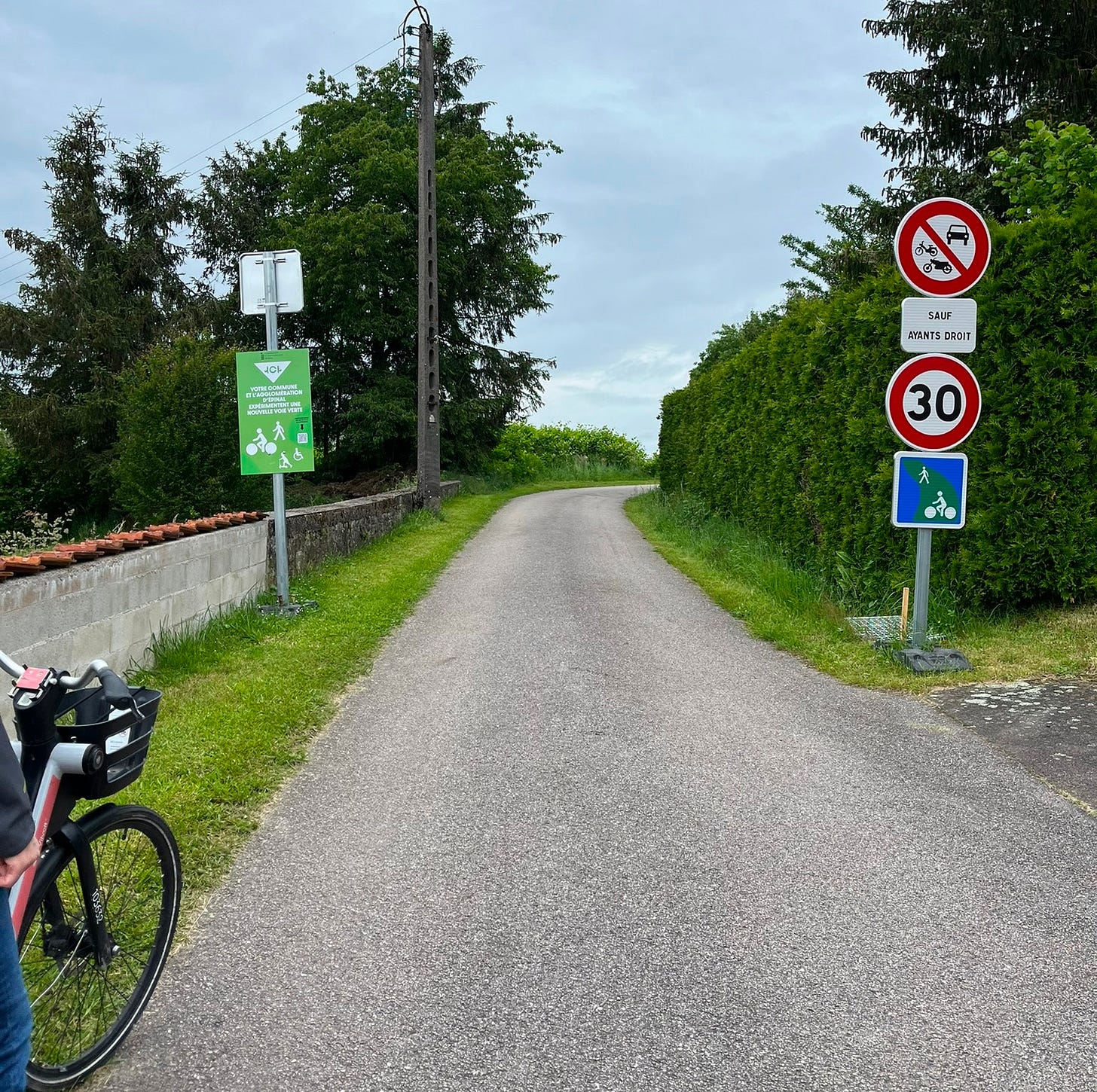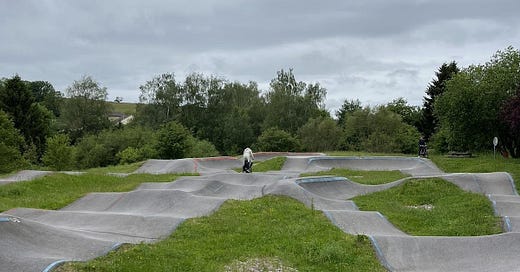The Ups and Downs of Cycling in Rural France: Insights From Interviews With Local Elected Officials
Rural Cycling | Perspectives | Épinal, France
Cycling in rural areas, whether in rural France or elsewhere, is still a relatively unexplored topic. As is the case in most sparsely populated lands, cars remain deeply ingrained in people’s everyday mobility routines, the bike being mostly considered as a leisure or sport activity. Our transition readiness study with the Communauté d’Agglomération of Épinal (CAE), an administrative association of 78 municipalities in the Vosges, France, has allowed us to gain insight into the challenges and opportunities associated with cycling transitions in rural territories.
The 78 municipalities span 13,000 square kilometers and are home to 111,000 residents. With 51 municipalities with less than 1,000 inhabitants, and 36 with less than 500, as reported by the president of the CAE, the region maintains a strong rural character. This, combined with sparse infrastructure and long distances between homes, workplaces, and amenities, fosters high car dependency. However, the CAE adopted the Mobility Plan in 2020, which aims to change that, with bold goals for decarbonized, inclusive, and bike-friendly transportation. Although the benefits of daily cycling are explicit in the plan, from enhancing physical and mental health to reducing air pollution and easing road congestion, the institutional frameworks, cultural reliance on cars, and lack of community representation, among other factors, pose challenges to a transition in rural areas.
The local politicians we spoke with are confident about the potential for this transition. The rapidly increasing bike share, disrupting the status quo, the use of tactical approaches to developing cycling routes, and the collaboration with schools were mentioned as the CAE’s unique levers to encourage people to embrace cycling. This article provides an overview of the challenges and opportunities for cycling in rural France, as recounted by the local elected officials during our visit to the region in May 2024.
Challenges to cycling in rural CAE
An institutional framework hampering the CAE’s cycling ambitions
While there is political will for the mobility transition at the level of the CAE, the same cannot be said across all multiple governance levels involved. While some municipalities have seen tremendous progress in the development of their cycling infrastructure over the past five years, others are lagging far behind, with some mayors still considering cycling a low priority in their municipal budgets. Other local elected representatives saw the responsibility for systemic change as lying with others, citing the complex institutional framework as a reason for inaction. To achieve a coherent transition across the CAE territory, cycling efforts cannot be limited to a few isolated municipalities. Interviewees emphasized the importance of cooperation among three key stakeholders to advance the CAE’s cycling ambitions. First are the municipalities, which play a critical role as they manage traffic within their territories, including roads, trails, public spaces, and schools. Second is the Grand Est Region, a key collaborator of the CAE for the management of rail transport. Third is the Vosges département, responsible for managing main roads that are often the most dangerous for cyclists. As a response, the cycling network that the CAE is developing largely avoids these roads. However, some cycling lanes must intersect or overlap with departmental roads, necessitating collaboration with the département. This has proven challenging due to the département's predominantly car-centric approach, which does not prioritize cycling and has led to both political and technical conflicts. This is just one example of the shared decision-making process across multiple governance levels further dilutes accountability, impeding the transition and favoring the status quo.
Cultural Barriers
The CAE’s Director and Deputy Director emphasized the need for a cultural transition. Local elected officials we spoke with expressed concern that the car-centric mobility culture in their region hinders the potential for such a shift. Issues like cyclists using sidewalks, behaviors often used as examples by skeptics to discredit cycling and related policies, while public and political resistance to reallocating road space, such as removing car parking for bike lanes, underscores the car's dominance. The fear of alienating citizens and harming commercial activity often stalls bold initiatives.
Lack of community representation
Another observation about the CAE, in contrast to the Netherlands, is the lack of bottom-up, grassroots community support for the transition despite efforts to develop infrastructure. Additionally, there is a noticeable absence of citizen representation in mobility planning. Existing cycling advocacy groups are limited in scope and fail to represent the broader population. Engaging citizens and creating advisory committees could fill this gap, fostering inclusivity and ownership of the cycling transition.
Opportunities for cycling in rural CAE
The success of the bike sharing system – disrupting status quo
One standout initiative, mentioned by multiple interviewees and a source of great pride for the CAE, is the public bike-sharing system introduced in 2021. The introduction of such a service in rural France is unprecedented. Available in 21 municipalities, the bike-share system features electric bikes that can travel up to 40 km on a single charge, with most trips averaging 4 to 10 km. The successful uptake and rapid expansion of the Vilvolt public bike-sharing system indicate a significant demand for such services and a growing preference for daily cycling. With 20,000 users already registered on the Vilvolt app and as it stands, a fleet size which is double its original size (200 to 460 bikes), there is tangible evidence of increased interest and demand for cycling in the region. The growing user base must be interpreted as the expression of a growing support for daily cycling in the region. It is, according to the Mobility Director of the CAE, what “brought bikes back in the streets”. The key aspects which make the program a success, according to interviewees, is the service’s:
Accessibility: With affordable tariffs, with pay-as-you-go rates of €1 per half-hour, or subscription options at €3/month or €30/year, including 30 minutes free daily. It also offers lower tariffs for users under 26, empowering youth to travel independently and providing a competitive alternative to cars, walking, and traditional cycling.
Ease of use: The electric assistance compensates for the hilly Vosges terrain. The president of the CAE shared the sentiment that before the e-bikes sharing system became popular, the hilly terrain of the region made daily cycling difficult.
Cultural shift facilitated by the pandemic: COVID-19 heightened interest in outdoor activities, accelerating demand for cycling options. The Director of Mobility added that while rural areas often tend to "self-disqualify" by arguing, "we are rural, we are small”, this bike-share system proved that this demand was underestimated and showed a willingness among citizens to use bicycles.
Infrastructure Impact: Visible bike stations have normalized cycling as a practical mode of transport. “When there are bike stations and sufficient population density, there's increased activity”, explained the Deputy Director. The deployment of the service across 21 municipalities allowed for movement within this perimeter and in particular, between the municipalities. The potential, as she explained, also lies in the fact that more than three-quarters of trips between 1–5 km in the most rural parts of the territory are made by car. These distances, with the right infrastructure that ensures safe cycling conditions, can easily be covered by bike. For medium and long distance journeys, however, the question lies more in improving the public transport offer through regional development.
Experimental cycling networks: tactical approaches
Cycling has long been popular in the area, but primarily as a sport and a significant tourist attraction, notably due to the renowned cycling route, V50, which crosses the Agglomération from south to north. However,
the recognition that sport-oriented cycling routes were insufficient to encourage cycling as a practical, everyday mode of transportation led the CAE to conclude that additional cycling infrastructure was necessary. To address this need, the CAE launched an experimental cycling network called the Réseau Vélo Tactique (Tactical Bike Network).This network features temporary green lanes on communal roads where only authorized vehicles and cyclists are allowed, with a speed limit of 30 km/h. The trial will continue until later 2024, aiming to test possible improvements and gather feedback from cyclists to adjust and potentially expand the routes. While experimental networks like these are common in urban areas, their implementation in rural France is groundbreaking. The mobility director of the CAE added: “From the perspective of the Netherlands it may seem normal to have this kind of network but here, if it works out, it would be totally extraordinary for a rural territory in France. It would also be a first at the national level - to transform so many car centric roads into green lanes”. The president of the CAE believes such initiatives could inspire healthy competition among municipalities, fostering collective progress.

Collaboration with schools to improve children’s access to public space
The CAE is leveraging its Mobility Plan to build partnerships, particularly with schools. As explained by the CAE's mobility director, although there is growing awareness of health issues among elected officials, there is no explicit link yet between the CAE's mobility decisions and physical and mental health, or youth autonomy, as they are "still at the observation stage." However, this is starting to change, as they admitted to trying to break out of their silo by using schools as a means to support a cultural shift in mobility: “We work with primary schools to help municipalities redesign the surroundings of schools so that children can go to school in ways other than by car with their parents. The central argument we use for this is health, for example to limit pollution and for children's physical activity, also because these are the arguments that resonate most with parents”. The ability of children to safely cycle is also the main factor in identifying a road as "cycling-friendly," according to the CAE’s mobility director. The director explained: “We consider our roads to be cycle-friendly if a family can let their children ride bikes alongside their parents, or if a teenager can ride to school alone. If this is not possible, it means the safety conditions are not met.” Additionally, the deputy mobility director views partnerships with schools as a strategic entry point to rework public spaces. She explained: “If we manage to transform the surroundings of all our schools, we will succeed in improving the quality of life for everyone”. Through this partnership, two schools in the territory have created playgrounds adjacent to the school.
The CAE – a model of rural innovation in daily cycling
The CAE’s efforts to promote cycling in a predominantly car-dependent, rural context are unique. Despite ongoing challenges, the CAE case demonstrates that cycling transitions are possible in rural areas, with potential for learning in similar regions in France and across Europe. The road ahead will require overcoming cultural skepticism, fostering better inter-municipal collaboration, among other challenges, and engaging with communities while developing opportunities for e-cycling.
Key takeaways
Institutional barriers hinder progress: As observed in the case of the CAE, despite commitment to advance cycling, the fragmented governance structure and lack of alignment between different levels of government create obstacles. Only a few municipalities prioritize cycling infrastructure, making coordinated efforts challenging.
The car-centric culture prevails – A strong car dependency in the region, coupled with skepticism toward cycling infrastructure, continues to be a major barrier. Public and political resistance to reallocating road space for cycling infrastructure remains a key challenge. Research confirms that due to the need for speed, the long travel distances, and the sparse distribution of jobs and amenities, rural households in France continue to rely on cars as their primary means of transportation, notably due to the lack of competitive alternatives to cars.
Lack of grassroots advocacy for cycling – Unlike in some other countries, there is a noticeable absence of bottom-up citizen-led initiatives supporting cycling. A greater emphasis on community engagement and representation in mobility planning could help accelerate the transition.
Bike-Sharing as a driving force – The Vilvolt bike-sharing system, introduced in 2021, has been a major success, showing the potential for e-bikes to shift attitudes toward daily cycling, especially among the youth, when made affordable and accessible.
Tactical urbanism as a taste test – The CAE’s Tactical Bike Network testing cycling-friendly rural roads with lower speed limits and designated green lanes could be replicated in other territories, as a model to test out for rural cycling development in France and beyond.
Schools as a catalyst for change – Collaboration with schools is emerging as a key strategy for fostering a cultural shift toward cycling. By redesigning school surroundings to encourage active travel, the CAE is integrating mobility and public health objectives.
Written by , Researcher at Urban Cycling Institute.
Interested in writing or sponsoring an article? Send us a pitch at media@urbancyclinginstitute.org
Learn more:








very interesting article, a lot of insights into how to develop rural cycling in Italian rural areas :)